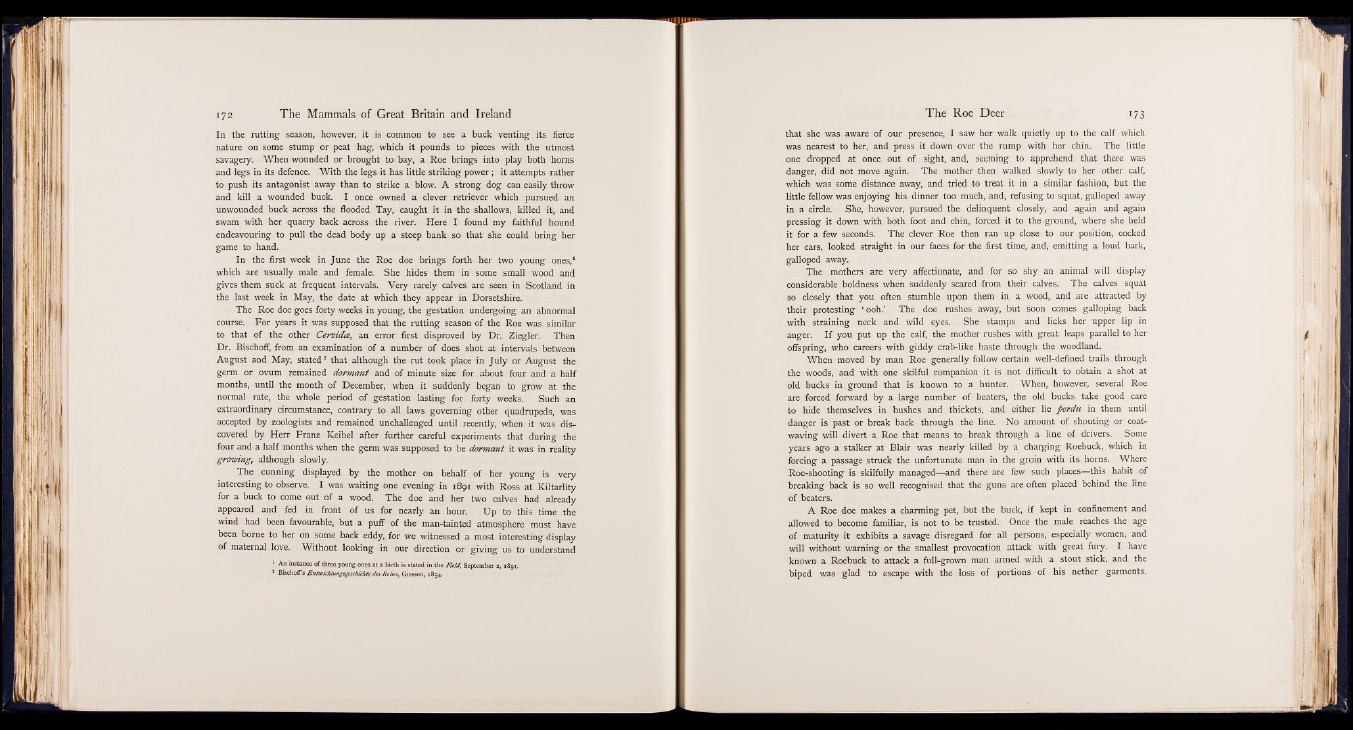
In the rutting season, however, it is common to see a buck venting its fierce
nature on some stump or peat hag, which it pounds to pieces with the utmost
savagery. When wounded or brought to bay, a Roe brings into play both horns
and legs in its defence. With the legs it has little striking power; it attempts rather
to push its antagonist away than to strike a blow. A strong dog can easily throw
and kill a wounded buck. I once owned a clever retriever which pursued an
unwounded buck across the flooded Tay, caught it in the shallows, killed it, and
swam with her quarry back across the river. Here I found my faithful hound
endeavouring to pull the dead body up a steep bank so that she could bring her
game to hand.
In the first week in June the Roe doe brings forth her two young ones,1
which are usually male and female. She hides them in some small wood and
gives them suck at frequent intervals. Very rarely calves are seen in Scotland in
the last week in May, the date at which they appear in Dorsetshire.
The Roe doe goes forty weeks in young, the gestation undergoing an abnormal
course. For years it was supposed that the rutting season of the Roe was similar
to that of the other Cervidce, an error first disproved by Dr. Ziegler. Then
Dr. Bischoff, from an examination of a number of does shot at intervals between
August and May, stated2 that although the rut took place in July or August the
germ or ovum remained dormant and of minute size for about four and a half
months, until the month of December, when it suddenly began to grow at the
normal rate, the whole period of gestation lasting for forty weeks. Such an
extraordinary circumstance, contrary to all laws governing other quadrupeds, was
accepted by zoologists and remained unchallenged until recently, when it was discovered
by Herr Franz Keibel after further careful experiments that during the
four and a half months when the germ was supposed to be dormant it was in reality
growing; although slowly.
The cunning displayed by the mother on behalf of her young is very
interesting to observe. I was waiting one evening in 1891 with Ross at Kiltarlity
for a buck to come out of a wood. The doe and her two calves had already
appeared and fed in front of us for nearly an hour. Up to this time the
wind had been favourable, but a puff of the man-tainted atmosphere must have
been borne to her on some back eddy, for we witnessed a most interesting display
of maternal love. Without looking in our direction or giving us to understand
1 An instance of three young ones at a birth is stated in the Field, September 2, 1891,
* BischofTs Entwicklungsgeschtihte des Rehes, Giessen, 1854.
that she was aware of our presence, I saw her walk quietly up to the calf which
was nearest to her, and press it down over the rump with her chin. The little
one dropped at once out of sight, and, seeming to apprehend that there was
danger, did not move again. The mother then walked slowly to her other calf,
which was some distance away, and tried to treat it in a similar fashion, but the
little fellow was enjoying his dinner too much, and, refusing to squat, galloped away
in a circle. She, however, pursued the delinquent closely, and again and again
pressing it down with both foot and chin, forced it to the ground, where she held
it for a few seconds. The clever Roe then ran up close to our position, cocked
her ears, looked straight in our faces for the first time, and, emitting a loud bark,
galloped away.
The mothers are very affectionate, and for so shy an animal will display
considerable boldness when suddenly scared from their calves. The calves squat
so closely that you often stumble upon them in a wood, and are attracted by
their protesting ‘ ooh.’ The doe rushes away, but soon comes galloping back
with straining neck and wild eyes. She stamps and licks her upper lip in
anger. I f you put up the calf, the mother rushes with great leaps parallel to her
offspring, who careers with giddy crab-like haste through the woodland.
When moved by man Roe generally follow certain well-defined trails through
the woods, and with one skilful companion it is not difficult to obtain a shot at
old bucks in ground that is known to a hunter. When, however, several Roe
are forced forward by a large number of beaters, the old bucks take good care
to hide themselves in bushes and thickets, and either lie perdu in them until
danger is past or break back through the line. No amount of shouting or coat-
waving will divert a Roe that means to break through a- line of drivers. Some
years ago a stalker at Blair was nearly killed by a charging Roebuck, which in
forcing a passage struck the unfortunate man in the groin with its horns. Where
Roe-shooting is skilfully managed— and there are few such places— this habit of
breaking back is so well recognised that the guns are often placed behind the line
of beaters.
A Roe doe makes a charming pet, but the buck, if kept in confinement and
allowed to become familiar, is not to be trusted. Once the male reaches the age
of maturity it exhibits a savage disregard for all persons, especially women, and
will without warning or the smallest provocation attack with great fury. I have
known a Roebuck to attack a full-grown man armed with a stout stick, and the
biped was glad to escape with the loss of portions of his nether garments.